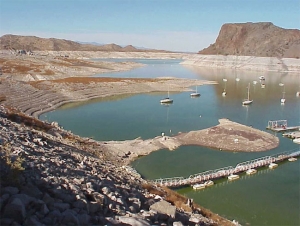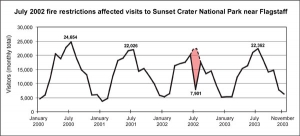Tourism and Recreation
 In the Southwest, climate is an important natural resource and a draw for tourists. Many people come to the region to take advantage of its warm, mild winters, to boat or kayak in the lakes and rivers, or to enjoy snow sports in the higher elevations. In addition, the natural beauty of the Southwest’s national parks attracts approximately 35 million visitors who spend an estimated $1.3 billion in the region annually (Figure 1). Regional projections suggest that temperatures will rise in the Southwest and precipitation will decrease. Consequently, climate change could affect tourism and recreation in the Southwest by:
In the Southwest, climate is an important natural resource and a draw for tourists. Many people come to the region to take advantage of its warm, mild winters, to boat or kayak in the lakes and rivers, or to enjoy snow sports in the higher elevations. In addition, the natural beauty of the Southwest’s national parks attracts approximately 35 million visitors who spend an estimated $1.3 billion in the region annually (Figure 1). Regional projections suggest that temperatures will rise in the Southwest and precipitation will decrease. Consequently, climate change could affect tourism and recreation in the Southwest by:
- Changing the length of tourism or recreation seasons
- Changing ecological systems
- Changing the physical environment
- Changing economic livelihoods
Changing the length of tourism or recreation seasons
Depending on location and activity, changes in season lengths could be positive or negative. Warm weather activities such as boating or camping might see an increase in the length of their operating seasons. Water activities, such as rafting and kayaking, could be affected by changes in seasonal precipitation patterns. Winter activities such as skiing or snowmobiling could be negatively affected by shorter, warmer winter seasons, as well as decreased precipitation. For example, the Arizona Snowbowl ski facility near Flagstaff is open an average of 96 days per season. However during the extremely dry winters of 2001–02 and 2005–06, the area was only open 4 and 16 days, respectively.
Changing ecological systems
Many tourist destinations and outdoor recreation activities are based on the presence of unique wildlife and plants. Dominant plant and animal populations could shift due to changes in climate, from wildfire, drought, or changes in precipitation and temperature. Several tourist and recreation destinations in the Southwest, including Saguaro National Park and Organ Pipe Cactus National Monument, offer unique desert ecosystems as primary attractions. Yet projections indicate these ecosystems are likely to shrink or migrate as the region warms.
 Changing the physical environment
Changing the physical environment
If natural features such as lakes or rivers are modified as a result of climate change, water-based tourism and recreation will be affected. Below-average water levels in lakes and reservoirs could reduce the number of boaters. Statistical analysis of tourism at Lake Powell suggests that for every 1 percent drop in reservoir levels, visits fall by 5 percent.1 If numbers are comparable for other reservoirs in the Southwest, such as Lake Mead or Elephant Butte, dry conditions will magnify decreases in tourism and economic impacts on local communities (Figure 2).
Increased frequency of extreme climate events such as drought, floods, wildfires, or severe storms could potentially damage tourism infrastructure, create hazardous conditions, and keep tourists away. For example, Sunset Crater National Monument in Arizona had a drop of 12,000 visits in July 2002, in part because of extreme drought and forest fire conditions (Figure 3). As a result, the local economy suffered an estimated loss of over $225,000.
Changing economic livelihoods
Many cities and recreation areas in the Southwest are economically dependent on tourism. Increased frequency of extreme climate events such as wildfires, drought, floods, or severe storms could damage tourism infrastructure, create hazardous conditions, and keep tourists away. For example, Morehouse and colleagues found that visits to New Mexico’s Bandelier National Monument were reduced by 7 percent during a year of extreme drought and by 21 percent due to the Cerro Grande fire in 2000.
Changes to the physical environment also have significant impacts on local tourism industries. Between 1999 and 2003, lake levels fell 5.4 percent at Lake Powell and 2.1 percent at Lake Mead. This drop in lake levels contributed to a drop of more than half a million visits to the Glen Canyon National Recreation Area in 2003, bringing a loss of $32.1 million in visitor spending, 758 jobs, and $13.4 million in personal income. At the Lake Mead National Recreation Area, lower lake levels contributed to approximately 900,000 fewer visits, with a $28.1 million loss in visitor spending, 680 lost jobs, and a $9.6 million loss in personal income.
Some recreation industries are investigating ways to deal with environmental changes that affect numbers of visitors. Ski resorts in Arizona, for example, are especially vulnerable to variability between snow seasons. Projections indicate that snowpack may decline as winters become warmer, especially at lower altitudes.
When there is below-average snowfall, ski resorts may rely on more expensive snowmaking techniques. Two resorts operate in Arizona, both of which help support surrounding communities through jobs, visitor spending, and tax revenues. Sunrise Park Resort in the White Mountains has snowmaking capability for 10 percent of its runs to augment the natural snowfall. This technique helps level out seasonal variability in snowfall, as long as temperatures remain cool enough to transform water into snow. But snowmaking has also created controversy in the Southwest. In August 2008, Arizona Snowbowl near Flagstaff received federal approval for a plan to make snow from treated wastewater. However, many regional environmental groups and Native American communities have opposed this plan for ecological, cultural, and spiritual reasons. Coming up with logical and economically viable human adaptations to climate change impacts can be quite complex.
References
-
Ponnaluru, Srinivasa. 2005. Visitation to the National Parks of the Southwest: The influence of economic and climate variables. MS Thesis. Department of Agricultural and Resource Economics, University of Arizona.
-
USDA. 2005. Final environmental impact statement for Arizona Snowbowl facilities improvements. Vol. 1. Coconino National Forest, Coconino County, Arizona.
-
Finch, Deborah M. (ed.). 2004. Assessment of grassland ecosystem conditions in the Southwestern United States. Vol. 1. Gen. Tech. Rep. RMRS-GTR-135-vol. 1. Fort Collins, CO: U.S. Department of Agriculture, Forest Service, Rocky Mountain Research Station.
-
Morehouse B., G. Frisvold, R. Bark-Hodgins. 2007. How can tourism research benefit from multi-disciplinary assessments of climate change? Lessons from the U.S. Southwest. In Matzarakis, A., C.R. de Freitas, and D. Scott. (eds.) Developments in Tourism Climatology. pp.274-281.
Figures
Figure 1. 2007 visits to Southwest national parks and attractions.
| Enlarge This Figure |
Credit: Gigi Owen, CLIMAS, The University of Arizona
Figure 2. Elephant Butte Reservoir.
| Enlarge This Figure |
Credit: George Frisvold, Agricultural and Resource Economics, The University of Arizona
Figure 3. July 2002 Fire restrictions affected visits to Sunset Crater National Park near Flagstaff, Arizona.
| Enlarge This Figure |
Credit: George Frisvold, Agricultural and Resource Economics, The University of Arizona

